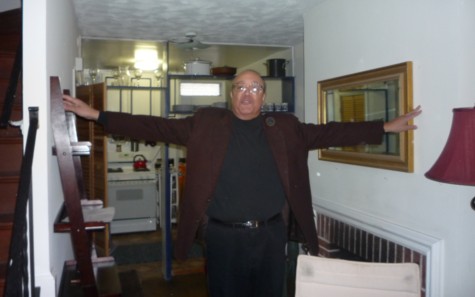 This week marks the third and last installment of the Gessford Court saga. Previous episodes have described the building of the houses on the alley and the transformation of Tiger Alley into Gessford Court. Today, I will be looking at the story of Gessford Court’s most famous resident, and the wide range of visitors who made their way there in the 1960s.
This week marks the third and last installment of the Gessford Court saga. Previous episodes have described the building of the houses on the alley and the transformation of Tiger Alley into Gessford Court. Today, I will be looking at the story of Gessford Court’s most famous resident, and the wide range of visitors who made their way there in the 1960s.
The most exciting time for Gessford Court was from the late-50s until the early 70s, when Adam Clayton Powell Jr, US Representative from Harlem, made his home there. Powell bought a number of the houses in the 1950s, fixed them up, and sold some of them, while keeping number 16 to live in and 18 to rent out. Powell lived in this small house while Congress was in session – alone for the most part. On weekends and during Spring Break, his son, Adam Clayton Powell III would come to visit, occasionally helping out in his father’s office for the princely sum of 25 cents a week.

Adam Clayton Powell III standing in 18, Gessford Court, in the same pose that his father used to use to show how small the house was.
In those months when Congress was in session, a steady stream of illustrious visitors gingerly made their way down the alley, looking for the house with the Jaguar parked out front, to have a quiet talk with the representative. Famous names included Hubert Humphrey and Barry Goldwater. Visitors were received in the small living room, whose furniture consisted of three chairs and a couple of TV tables. Such cramped quarters were a small price to pay for the opportunity of a quiet chat with the powerful head of the Education and Labor Committee, meetings that were unlikely to be noticed by the press: the only reporters who made their way to Gessford were those working for the African-American press.
Even the FBI paid a visit, though they did so when Powell was at work, and broke a window in order to gain entrance. Powell and his son came home during the day unexpectedly, and Powell’s son noticed something amiss with the rear window. He thought there was a bird sitting in front of it; his father explained that the window was actually broken. As they pulled in front of the house, they saw someone make his escape around the back of the alley. Inside, nothing had been taken, though papers had been disturbed, and there was glass on the Representative’s bed in the back bedroom. Powell immediately realized that this was no ordinary burglary, and suspected that it had been performed at J. Edgar Hoover’s direction.
When Powell called the head of the FBI to ask what that was all about, Hoover claimed that they were acting on some threat or another. Powell accepted the FBI chief’s explanation, but asked that in the future, they make use of the key hidden under the door mat to spare him the expense of a new window, and the trouble of cleaning glass shards off of his bed.
While Hoover’s minions had no problem finding the place, even today, the police have difficulty finding it, and all Gessford residents have stories about the difficulties they face in getting services for their street. They unanimously agree, however, that any problems their secluded street may bring are far outweighed by the pluses of living in such a peaceful place.
Today, the quiet is only occasionally broken by the sounds of the 21 Gessford Court Jazz Band, which plays impromptu concerts in the alley, as well as bands of children bursting out of houses and riding bikes up and down the brand new bricks lining the alley.
